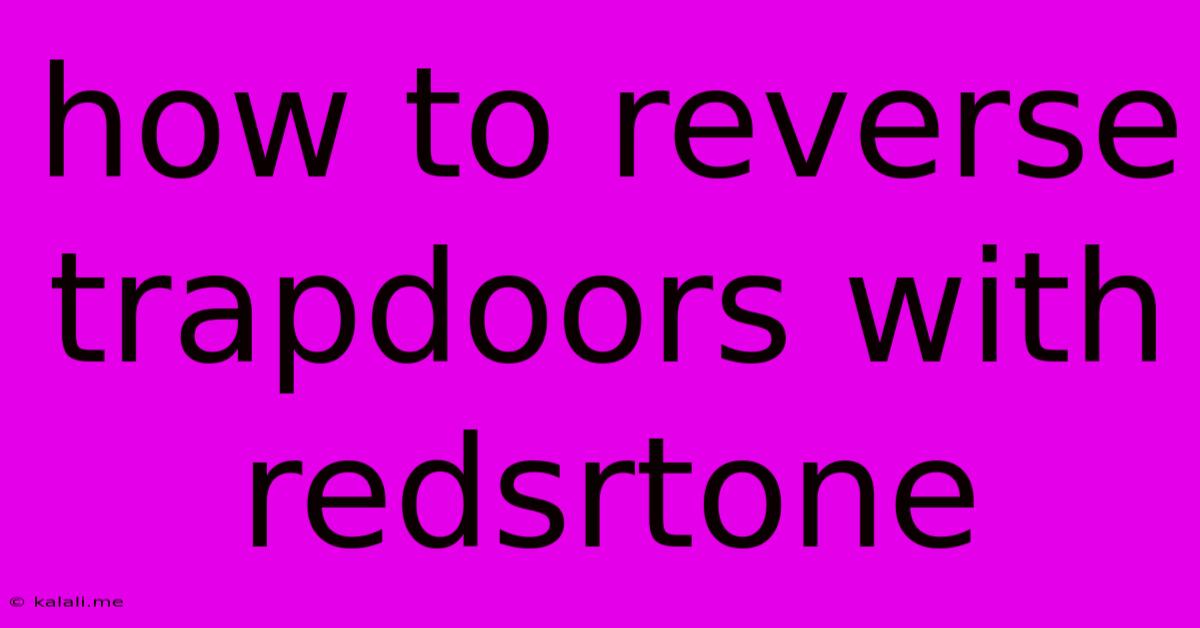How To Reverse Trapdoors With Redsrtone
Kalali
Jun 07, 2025 · 3 min read

Table of Contents
How to Reverse Trapdoors with Redstone: A Comprehensive Guide
This article explores various methods for reversing trapdoors using redstone in Minecraft, a popular technique for creating secret passages, hidden rooms, and intricate contraptions. We'll cover simple setups for beginners and more advanced designs for experienced redstone engineers. Understanding this will allow you to build impressive and functional redstone contraptions. Whether you're aiming for a simple hidden entrance or a complex mechanism, this guide will equip you with the knowledge to achieve your goals.
What are Reverse Trapdoors and Why Use Them?
In Minecraft, trapdoors are commonly used as simple doors. However, their unique mechanism allows for clever applications using redstone. A reversed trapdoor is one that opens (or closes) opposite to the typical behaviour. Instead of closing when powered, it opens. This creates an element of surprise and allows for sophisticated hidden passage creation.
Method 1: The Simple Observer Setup (Beginner Friendly)
This method is ideal for beginners, relying on the simple mechanics of observers and redstone dust.
- Materials: A trapdoor, an observer, and redstone dust.
- Setup: Place the observer next to the trapdoor, pointing towards it. The trapdoor should be placed in the block the observer is facing. Connect the observer's output with redstone dust to your activation switch (e.g., a button, lever, or pressure plate).
- Mechanism: When the switch is activated, the redstone signal powers the observer, causing it to detect the block update of the trapdoor. This, in turn, will trigger the trapdoor to open despite the redstone signal being on the observer.
Advantages: Extremely simple to build and understand. Disadvantages: Only suitable for single trapdoors. Scaling this to multiple trapdoors would require a significant increase in components.
Method 2: Using Repeaters and Comparators (Intermediate)
This method offers more control and scalability compared to the observer method.
- Materials: Trapdoor, redstone dust, repeaters, and comparators.
- Setup: Place the trapdoor. Behind the trapdoor, place a comparator pointing away from the trapdoor. This comparator will receive a signal from the redstone dust behind the trapdoor. Connect the comparator's output to a repeater and use that repeater's output to power the trapdoor.
- Mechanism: When the circuit is activated, the initial redstone signal to the comparator's input will be cancelled, preventing a signal from exiting the comparator and the trapdoor will open.
- Controlling the Opening/Closing: Add a switch to control the initial redstone input to the comparator.
Advantages: More control over the opening and closing mechanism. Can be scaled to multiple trapdoors with more careful planning. Disadvantages: Slightly more complex to build and understand than the observer method.
Method 3: Advanced Designs with Sticky Pistons (Advanced)**
For complex setups, such as hidden rooms or automated mechanisms, you can use sticky pistons in conjunction with other redstone components. This requires a solid understanding of redstone mechanics. This would involve using sticky pistons to pull or push blocks that in turn control the trapdoor, opening or closing it based on the activation of a more elaborate redstone circuit. This approach allows for highly customizable and intricate designs but is beyond the scope of a beginner-level explanation. Extensive experimentation and knowledge of redstone circuitry are required.
Advantages: Highly customizable and allows for complex integrated mechanisms. Disadvantages: Significantly more complex to design, build and troubleshoot.
Tips for Successful Redstone Trapdoor Reversal:
- Careful Planning: Before building, plan your design on paper or in a creative mode world.
- Testing: Test your creation thoroughly to identify and fix any issues.
- Redstone Dust Placement: Ensure proper placement of redstone dust to avoid signal interference.
- Troubleshooting: If your design isn't working as expected, carefully check all connections and signal paths.
Mastering redstone trapdoor reversal opens up a world of creative possibilities in Minecraft. By starting with the simpler methods and gradually progressing to more advanced techniques, you can build amazing and functional redstone contraptions. Remember to experiment, learn from your mistakes, and have fun!
Latest Posts
Latest Posts
-
How To Dry Out A Book
Jun 07, 2025
-
How Much Space Does A Cat Need
Jun 07, 2025
-
Is Crushed Red Pepper The Same As Cayenne Pepper
Jun 07, 2025
-
Why Isnt Alfred File Search Working Ventura
Jun 07, 2025
-
Scriptures On The Last Days In The Bible
Jun 07, 2025
Related Post
Thank you for visiting our website which covers about How To Reverse Trapdoors With Redsrtone . We hope the information provided has been useful to you. Feel free to contact us if you have any questions or need further assistance. See you next time and don't miss to bookmark.